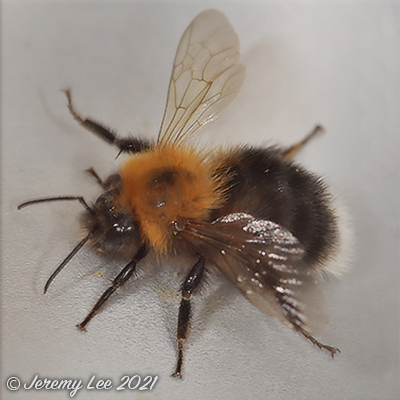
 |
|
Scientific Classifications explained » Amphibians » Ants » Aphids » Bees » Beetles » Birds » Bugs » Butterflies » Caterpillars » Damselflies » Dragonflies » Earwigs » Flies » Frog/Leafhoppers » Fungi » Galls » Grasshoppers » Harvestmen » Hoverflies » Lacewings » Ladybirds » Leaf Mines » Lichens » Mammals » Millipedes » Mosses » Moths » Sawflies » Slugs » Snails » Spiders » Trees & Shrubs » Wasps » Wild Flowers » Woodlice » Postboxes |
UK Nature > Bees > Bombus hypnorum

Scientific Name: Bombus hypnorum Common Name: Tree Bumble Bee Bombus hypnorum, more commonly known as the Tree Bumble Bee, is a species of bumble bee that is common on the European continent and parts of Asia. It has recently spread to United Kingdom and Iceland. Bombus hypnorum has a short proboscis and a rounded head. The thorax is usually of a uniformly ginger colour (but examples with a darker, or even black thorax occur), the abdomen is black haired and the tail always white. The bumblebee was first observed in the UK on 17 July 2001, close to the village of Landford in Wiltshire, and has since been spreading widely. It often lives near human settlements and prefers to build its nest above ground and often inhabits bird boxes. The nest is quite large, 150 workers or more (according to some authorities up to 400). The species is a pollen storer, i.e. it stores pollen in separate cells and feeds each larva individually, instead of storing the pollen directly in the larval cells. It visits an enormous range of flowering plants such as Rhododendron, cherry, grape hyacinth and, in the north, Vaccinium. It is an important visitor to Raspberry (Rubus idaeus) and Bramble (Rubus fruticosus agg.). The species has a short breeding cycle, with queens emerging early, usually in March. The first cycle is completed from mid-May to early July (depending on the season). A smaller second generation is produced in late summer in favourable years. It is generally quite docile but if disturbed can defend its nest pro-actively and it has been known to sting people who it perceives as a threat. |
|

https://www.uknature.co.uk is a website dedicated to showing the immense diversity of UK nature and wildlife. Our vast range of habitats, from lowland arable to snow covered mountains, from storm-ravaged coastlines to peaceful inland freshwater lakes and rivers, from dry, sandy heaths to deciduous and coniferous forests, all these habitats contribute to the abundance of UK nature. We have wild birds in huge numbers either residing or visiting our shores (597 recorded species as at July 2013) and we must also not forget the humble back garden with its grass lawns, flower beds filled with nectar rich flowers, shrubs and trees, all designed to attract huge numbers of insects such as bees, moths, butterflies and hoverflies; and finally the small ponds which provide safe havens for frogs, toads, newts and even slow worms and grass snakes. www.uknature.co.uk is the showcase for my personal passion, photographing uknature in all its glory. I sincerely hope you all enjoy the fruits of my labours. This site and all images contained therein is © Jeremy Lee 2004 - 2025. All Rights Reserved. Site design by Jeremy Lee. Site development & IT Support by Stuart Lee. |